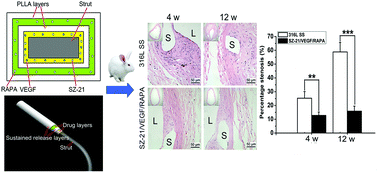当前位置:
X-MOL 学术
›
Biomater. Sci.
›
论文详情
Our official English website, www.x-mol.net, welcomes your
feedback! (Note: you will need to create a separate account there.)
Design, preparation and performance of a novel drug-eluting stent with multiple layer coatings†
Biomaterials Science ( IF 5.8 ) Pub Date : 2017-06-20 00:00:00 , DOI: 10.1039/c7bm00417f Tingzhang Hu 1, 2, 3, 4, 5 , Song Lin 1, 2, 3, 4, 5 , Ruolin Du 1, 2, 3, 4, 5 , Meiling Fu 1, 2, 3, 4, 5 , Qiong Rao 1, 2, 3, 4, 5 , Tieying Yin 1, 2, 3, 4, 5 , Yan Huang 5, 6, 7 , Guixue Wang 1, 2, 3, 4, 5
Biomaterials Science ( IF 5.8 ) Pub Date : 2017-06-20 00:00:00 , DOI: 10.1039/c7bm00417f Tingzhang Hu 1, 2, 3, 4, 5 , Song Lin 1, 2, 3, 4, 5 , Ruolin Du 1, 2, 3, 4, 5 , Meiling Fu 1, 2, 3, 4, 5 , Qiong Rao 1, 2, 3, 4, 5 , Tieying Yin 1, 2, 3, 4, 5 , Yan Huang 5, 6, 7 , Guixue Wang 1, 2, 3, 4, 5
Affiliation

|
Drug-eluting stents (DESs) can effectively control the harmful effects of coronary artery disease, because of their excellent ability to reduce in-stent restenosis. However, delayed re-endothelialization and late stent thrombosis have caused concern over the safety of DESs. In this study, according to time-ordered pathological responses after stent implantation, a hierarchical multiple drug-eluting stent was designed and prepared to overcome the existing DES limitations. A platelet membrane glycoprotein IIIa monoclonal antibody (SZ-21) and a vascular endothelial growth factor (VEGF121) were loaded into the inner coating of 316L stainless steel (316L SS) stents to inhibit thrombosis and promote re-endothelialization; rapamycin (RAPA) was loaded into the third layer to inhibit intima hyperplasia; a drug-free poly-L-lactic acid coating was located on the second and fourth layers and used as sustained release layers. The results showed that the three drugs exhibited sequential release kinetics without significant burst release. RAPA released quickly at the early stage, while SZ-21 and VEGF121 achieved a slow and prolonged release. In vitro experiments showed that the stents had excellent hemocompatibility and anti-inflammatory properties, and promoted the proliferation and migration of endothelial cells while inhibiting the proliferation and migration of smooth muscle cells. Finally the stents were implanted in the carotid arteries of New Zealand white rabbits. In vivo results showed that compared to 316L SS stents, the multiple drug-eluting stents could accelerate re-endothelialization and inhibit thrombosis, inflammation and in-stent restenosis after 4 weeks (12.79 ± 2.45% vs. 25.27 ± 4.81%) and 12 weeks (15.87 ± 3.62% vs. 58.84 ± 6.87%). These results indicate that the novel drug-eluting stent with multiple layer coatings will have a highly potential clinical application.
中文翻译:

具有多层涂层的新型药物洗脱支架的设计,制备和性能†
药物洗脱支架(DESs)具有出色的减少支架内再狭窄的能力,因此可以有效控制冠状动脉疾病的有害影响。然而,延迟的重新内皮化和晚期的支架血栓形成已经引起对DESs安全性的关注。在这项研究中,根据支架植入后的时间顺序病理反应,设计并准备了多层多药物洗脱支架,以克服现有DES的局限性。血小板膜糖蛋白IIIa单克隆抗体(SZ-21)和血管内皮生长因子(VEGF 121)装入316L不锈钢(316L SS)支架的内涂层中,以抑制血栓形成并促进重新内皮化;将雷帕霉素(RAPA)装入第三层以抑制内膜增生。将无药物的聚-L-乳酸涂层置于第二和第四层上,并用作缓释层。结果表明,这三种药物表现出顺序释放动力学,而没有明显的爆发释放。RAPA在早期迅速释放,而SZ-21和VEGF 121则缓慢缓慢地释放。体外实验表明,该支架具有良好的血液相容性和抗炎特性,并在抑制平滑肌细胞增殖和迁移的同时,促进了内皮细胞的增殖和迁移。最后,将支架植入新西兰白兔的颈动脉中。体内结果显示,与316L SS支架相比,多药洗脱支架可在4周(12.79±2.45%对25.27±4.81%)和12周后加速内皮再血管化并抑制血栓形成,炎症和支架内再狭窄。 (15.87±3.62%对58.84±6.87%)。这些结果表明具有多层涂层的新型药物洗脱支架将具有高度潜在的临床应用。
更新日期:2017-06-20
中文翻译:

具有多层涂层的新型药物洗脱支架的设计,制备和性能†
药物洗脱支架(DESs)具有出色的减少支架内再狭窄的能力,因此可以有效控制冠状动脉疾病的有害影响。然而,延迟的重新内皮化和晚期的支架血栓形成已经引起对DESs安全性的关注。在这项研究中,根据支架植入后的时间顺序病理反应,设计并准备了多层多药物洗脱支架,以克服现有DES的局限性。血小板膜糖蛋白IIIa单克隆抗体(SZ-21)和血管内皮生长因子(VEGF 121)装入316L不锈钢(316L SS)支架的内涂层中,以抑制血栓形成并促进重新内皮化;将雷帕霉素(RAPA)装入第三层以抑制内膜增生。将无药物的聚-L-乳酸涂层置于第二和第四层上,并用作缓释层。结果表明,这三种药物表现出顺序释放动力学,而没有明显的爆发释放。RAPA在早期迅速释放,而SZ-21和VEGF 121则缓慢缓慢地释放。体外实验表明,该支架具有良好的血液相容性和抗炎特性,并在抑制平滑肌细胞增殖和迁移的同时,促进了内皮细胞的增殖和迁移。最后,将支架植入新西兰白兔的颈动脉中。体内结果显示,与316L SS支架相比,多药洗脱支架可在4周(12.79±2.45%对25.27±4.81%)和12周后加速内皮再血管化并抑制血栓形成,炎症和支架内再狭窄。 (15.87±3.62%对58.84±6.87%)。这些结果表明具有多层涂层的新型药物洗脱支架将具有高度潜在的临床应用。











































 京公网安备 11010802027423号
京公网安备 11010802027423号